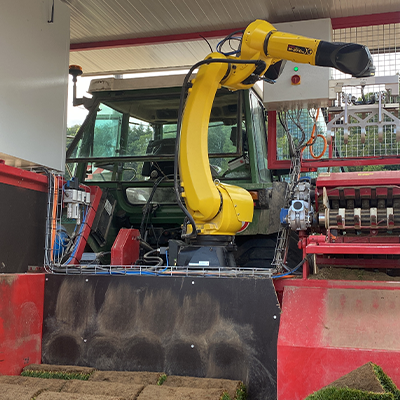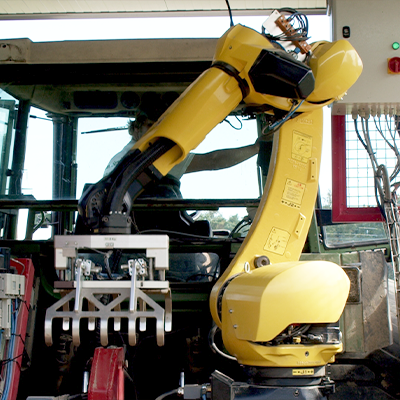 How a robot became a farmer
How a robot became a farmer
“Turf harvesting has always been a very demanding process, with each roll weighing around 15 kg,” states Ernst Brandenberger, founder and managing director of Green Services GmbH. “In line with our ethos of continuous improvement, we began looking for an automated solution that would ease the highly physical task of turf palletising.”
Green Services reached out to TwinAutomation GmbH, a Switzerland-based specialist in the design and manufacture of customised solutions for a wide range of industries. Offering full project management from initial concept to final commissioning, TwinAutomation regularly incorporates FANUC robots into its customer projects. Today, most of the machines built by the company feature robotics.
 “We were very interested in this project from the outset because it was something totally different,” says Michael Studer, managing director of TwinAutomation.
“We were very interested in this project from the outset because it was something totally different,” says Michael Studer, managing director of TwinAutomation.
Like many machine builders and system integrators, TwinAutomation usually focuses on industrial applications, where precision engineering, standard operating procedures and conformity are the norm. As a natural product, turf is different.
“For example, the moisture content changes every day, which means that turf properties tend to fluctuate,” explains Mr Studer. “The rolling behaviour differs, as does the strength and firmness. Furthermore, vibrations from the harvester engine have a negative effect on palletisation.”
It was clear that the turf palletising application at Green Services called for an extremely reliable robot in terms of control, performance and service life. With this thought in mind, TwinAutomation opted for a FANUC M-20iD/35 6-axis industrial robot offering 35 kg payload and 1831 mm reach.
“There are many untapped applications for industrial robots in the agriculture industry, so it was an exciting opportunity to show what we could do,” says Mr Studer. “We prepared the FANUC robot with the gripper at our premises, with assembly and commissioning taking place at the site of Green Services. We mounted the robot inside an existing turf harvester and set about automating the palletising operation.”
TwinAutomation fitted various safety options to the vehicle, such as a powered drop-down security gate on the rear of vehicle that closes when the FANUC robot is in operation. Further support for safety comes courtesy of FANUC DCS (Dual Check Safety) software, so staff can work in complete safety.
With the automation system now fully operational at Green Services, palletising capacity is around 500 rolls per hour based on a 7 second cycle time.
“Through this innovative approach we were able to save about 45% working time and provide massive physical relief for our staff,” reports a highly satisfied Mr Brandenberger. “We have also become more flexible in production.”
Mr Berger concludes by adding: “In our industry, when we say ‘in the field’ it usually means in operation at a manufacturing or process plant, but it’s adopted a very literal meaning in this project.”